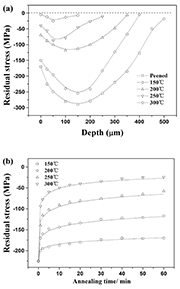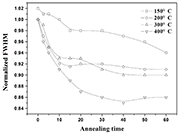E-Archive
Articles
in Vol. 17 - May Issue - Year 2016
Influence of Isothermal Annealing on Stress Relaxation of Shot-Peened SiCw/Al Composite

Tab. 1: The chemical composition of 6061Al alloy

Tab. 2: Mechanical properties of 6061Al alloy and SiCw/6061Al composites

Fig. 1: (a) Depth distribution of residual stresses of shot-peened SiCw/6061 Al composites after annealing with temperatures 150

Fig. 2: FWHM of peened SiCw/Al composites vs annealing time t with different temperatures, Al (311) reflection
Abstract
The residual stress relaxation of the shot-peened layer on the SiCw/Al composite during isothermal annealing was investigated. The results showed that the residual stresses relaxed in the whole deformation layer, especially when the annealing temperature was higher than 200°C. The relaxation process during isothermal annealing could be described using Zener-Wert-Avrami function when the annealing temperature was larger than 200°C. Because of high-intensity dislocation around reinforcements producing a large amount of stored energy, activation enthalpy of shot peened SiCw/Al was smaller than self-diffusion activation enthalpy of pure aluminum. According to the full width at half maximum (FWHM) of the shot-peened composite vs time in different temperatures annealing, it can be concluded that the recovery and recrystallization behavior became intense when annealing temperature was larger than 200°C. The small relaxation of residual stress in low annealing temperature was mainly due to partly recovery and recrystallization in a very low level.
1. Introduction
Shot peening (SP) is an effective method to improve metallic components' fatigue strength and fatigue life by means of introducing compressive residual stresses and work-hardening states into those components. Therefore, the stability of residual stress field induced by shot peening is a very important factor of component' fatigue strength and fatigue life [1-3]. The residual stress field stability is related to the elastic deformation energy inside material, and the value of residual stress can be considered as a deviation from material equilibrium state. In thermodynamics, the high energy state always transforms to a low energy state, which is the internal dynamic force for residual stress relaxation. Beside internal factors, there are two main categories of external factors, which can promote residual stress relaxation, temperature [4] and loading [5]. The relaxations in traditional alloys and metals have been extensively investigated [6-9]. However, the residual stress relaxation behaviors of metal matrix composites (MMCs) after SP treatment, especially in temperature annealing, have been carried out only by few works [4, 10]. As a lot of MMCs components are served at relatively high temperature conditions, the understanding of the residual stress and work-hardening relaxation of MMCs components in high temperature (higher than room temperature) is crucial for the fatigue properties improvement of this kind of material component [7]. Therefore, a parametric study on residual stress and work-hardening relaxation of MMCs components after SP was carried out on SiCw/Al composite in this work. By accurately documenting the changes of residual stresses and FWHM under different temperature annealing conditions, the influence of temperature on residual stresses and microstructure were evaluated and discussed.
2. Experiment
The SiCw/Al composite (in situ, 15 vol.% SiCw) used in this paper was synthesized according to Refs [11]. The reinforcement in composite was SiCw whisker. The diameter of whisker was about 1?m and the length of whisker was about 15?m. Tab.1 shows the chemical composition of 6061 Al alloy. The mechanical properties of matrix Al (6061 Al alloy) and SiCw/Al composite are listed in Tab. 2 respectively. Before SP, heat treatments were conducted: solution treatment at 530°C for 120min, then quenched in water, and finally aging at 170°C for 6h. All the specimens were cut with the dimensions of 15mm x 10mm x 4mm. The SP intensity was 0.3mmA for all specimens in order to make sure the initial microstructure and residual stresses were uniform before different temperature isothermal annealing treatments. Isothermal annealing treatments were carried out at 150°C, 200°C, 250°C and 300°C for 1h respectively. The measurements of the depth distribution of the residual stresses were performed by iterative electrolytic removal of thin surface layers and subsequent X-ray measurements. Residual stress tests were determined by the X-ray stress analyzer according to the sin2? method via Cr-Ka radiation. FWHM were determined by X-ray diffraction profiles via Cu-Ka radiation. The detected peaks in both residual stress and FWHM measurements were Al (311) diffraction profiles. Residual stress and FWHM of all tested areas were measured three times and averaged.
3. Results and Discussion
During the shot peening process, a great amount of balls fired at high velocity impact on the surface of the specimen, which causes elastic and plastic deformation. As a result, a compressive residual stress field is introduced at and beneath the exposed surface layer. However, these residual stresses could relax significantly in thermal loading due to recrystallization. Fig. 1a shows the depth profiles of the residual stresses of the peened SiCw/6061Al composites after being annealed for 1h at the temperatures 150°C, 200°C, 250°C, 300°C respectively. The results showed that the higher the temperature, the more obvious the stress relaxation. The stress relaxation was relatively small when the annealing temperature was 150°C. At the annealing temperature 300°C, the recrystallization had been completed, which results in almost complete stress relaxation.
In order to investigate the stress relaxation development at different annealing temperatures, stress measurements were carried out on annealing specimens at different time points. For the purpose of getting larger initial residual stress value, the residual stress values at 25?m depth were measured by X-ray measurement after electrolytic removal of 25?m depth surface layers in all specimens. The surface residual stress relaxation time history analysis at different annealing temperatures is shown in Fig. 1b. It could be seen that with the annealing time increasing, the residual stresses relaxed rapidly in the early period, and then the relaxation rates became slow in all annealing temperatures. The longer the annealing time and the higher the annealing temperature, the more obvious the stress relaxation. After annealing, the residual stresses of the specimen annealed at 150°C decreased 24% (from -225MPa to -170MPa) but the residual stresses of the specimen annealed at 300°C relaxed almost completely, which was identical to the result shown in Fig.1a.
The residual stress relaxation of peened MMCs in high temperature is a thermally activated process. During the annealing process, creep deformation takes place in some regions of peened MMCs specimen in high temperature annealing conditions, which results in some or even complete residual stress relaxation. Thermal relaxations of residual stresses are controlled by a thermally activated mechanism which can be described by a Zener-Wert-Avrami function [8,9,12]:
"formula cannot be displayed online" (1)
where ? is the initial residual stresses, ? is the residual stresses under temperature T and time t, m is a numerical parameter dependent on relaxation mechanism. For non-ferrous alloys, the value of m should be between 0.1 and 0.3[13]. C is a temperature function depending on the material property according to:
"formula cannot be displayed online" (2)
Where D is the material constant, k is the Boltzmann constant with value of 8.617343x10-5eV/K. ?H is the activation enthalpy for stress relaxation process. According to eq. (1), (2) and the datum in Fig. 1b, the specific values of the residual stress relaxation process can be calculated. The following equation describes the stress relaxation through regression analysis:
"formula cannot be displayed online" (3)
The results showed that the activation enthalpy for stress relaxation of SiCw/Al composite was 1.40eV. Comparing this value with a previous result [10], it could be seen that the activation enthalpy for stress relaxation of SiCw/Al composite was not only smaller than the activation enthalpy for stress relaxation of TiB2/Al composite (1.64ev), but also even smaller than the self-diffusion activation enthalpy of aluminum (1.45eV). As the reinforcements always acted as sink sources of dislocations during repeated deformation [14], the dislocation density around reinforcement increased significantly [15]. On the one hand, the high dislocation density around reinforcement particles could increase the stored energy and make the dislocation in an unstable state, which could promote the recrystallization and the growth of a recrystallization nucleus [16, 17]. At high temperature annealing, the capability of dislocation movement and the rates of dislocation annihilation and rearrangement increased, which led to dislocation density decrease and residual stress relaxation. However, on the other hand, the reinforcement particle strength was still very high during the annealing process, which could hinder the dislocation movement [18]. These two controversial factors determined the value of activation enthalpy for stress relaxation. As we know, the movements of dislocation were impeded by the pinning role of the reinforcements, especially the reinforcement sizes were small and the reinforcement distributions were uniform. In the TiB2/Al composite, the sizes of TiB2 reinforcement particles were very small (the average dimension was from 50-500nm) but in the SiCw/Al composite, the sizes of SiCw reinforcement whiskers were relatively larger (the diameter of whisker was about 1?m and the length of whisker was about 15?m). Therefore, the activation enthalpy for stress relaxation of the SiCw/Al composite was smaller than that of the TiB2/Al composite. Furthermore, in the SiCw/Al composite, the increment of stored energy induced by high dislocation density around reinforcement particle was dominating factor so that the activation enthalpy for stress relaxation of TiB2/Al composite was even less than that of pure aluminum.
In the annealing process, temperature not only influenced the residual stress field of the MMCs specimen but also influenced its microstructure. In order to investigate the recrystallization behavior of the SiCw/Al composite during isothermal annealing process, different annealing temperatures were carried out on SiCw/Al composite specimens and structural breadth FWHM development at different annealing temperatures were calculated by the Gaussian method shown in Fig. 2. The FWHM values at 25?m depth were measured as standard width for comparison by X-ray measurement. It could be seen that the FWHM values decreased with increasing time in all temperature annealing processes, which meant the peening microstructures recovered and recrystallized during annealing. According to the Scherrer equation, the decrement of FWHM means grain size became larger. In the 150°C annealing condition, the FWHM decreased slowly, which meant recovery and recrystallization behavior took place in only one part of the SiCw/Al composite specimen. However, when the annealing temperature became higher, FWHM decreased rapidly in the initial period of annealing, which meant the internal energy of the SiCw/Al composite specimen was larger than recrystallization activation energy of SiCw/Al composite at this temperature. Grains grew very quickly and the stored energy induced by high dislocation density promoted this process, which led to residual stress full relaxation.
4. Conclusion
The thermal relaxation of residual stresses in shot peening layer of SiCw/Al composite specimens was investigated. The results showed that the residual stresses were relaxed in the whole deformation layer, especially in the initial period of annealing. The residual stress relaxation behavior was in accordance with the Zener-Wert-Avrami function when the annealing temperature was higher than 200°C. The regression equation
was "formula cannot be displayed online"
which meant the residual stress relaxation of SiCw/Al composite during annealing was a creeping process. As the size of SiCw/Al reinforcement particle became relatively larger, the hindrance effect of reinforcement particles on dislocation movement became relatively smaller and the high stored energy induced by high dislocation density around the reinforcement particle was the dominating factor during the annealing process. Furthermore, according to FWHM analysis during the annealing process, it could be seen that severe recovery and recrystallization behavior took place when the annealing temperature was higher than 200°C. The small relaxation of residual stress at low annealing temperature was mainly due to partial recovery and recrystallization at a very low level.
For Information:
Saipu Metal Products Co.,LTD
A-13 Minhao, Industrial Park 224300
Yancheng Jiangsu, China
Tel. +86.515.6996-6366
E-mail: nabrasive@vip.163.com
www.superiorcutwireshot.com



























